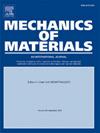视神经的孔弹性模型显示了流体压力对神经纤维的显著影响
IF 3.4
3区 材料科学
Q2 MATERIALS SCIENCE, MULTIDISCIPLINARY
引用次数: 0
摘要
视神经的结构类似于一个圆柱形的复合物,其中软脑膜包围着充满间质液的神经组织。这种间质液对于视觉信号的有效神经传导是必要的。视神经对生理负荷的反应尚不清楚。目前的计算和材料模型并没有完全捕捉到这种组织结构的复杂性,特别是生物流体尚未被认为是一种负载支撑材料。我们开发了一个微观结构驱动的圆柱形复合材料的分析模型,具有孔弹性核心和弹性外层受到轴向载荷。我们研究了复合材料的几何形状和材料参数对复合材料应力分布的影响。我们发现了与生理相关的条件,当外层和生物流体相对于核心的固体成分支持大部分施加的应力时。该模型表明,流体压力可达施加应力的三分之一。该模型使液体压力损伤神经纤维成为可能。在将视神经建模为弹性固体的研究中,这种情况是缺失的。我们研究了动物神经或材料的外层厚度和可压缩性的变化如何使应力-应变反应变硬。本研究为测量和比较患病、衰老和健康神经与类似生物材料之间的材料参数提供了指导。该模型可用于类似复合材料的力学分析。本文章由计算机程序翻译,如有差异,请以英文原文为准。

A poroelastic model of the optic nerve shows a significant effect of fluid pressure on the nerve fibers
The structure of the optic nerve resembles a cylindrical composite where the pia mater surrounds the nervous tissue which is saturated with interstitial fluid. This interstitial fluid is necessary for effective nerve conduction of visual signals. The reaction of the optic nerve to physiological loads remains unknown. Current computational and material models do not fully capture the complexities of this tissue's structure, particularly the biofluid has not yet been considered as a load-supporting material. We developed a microstructurally motivated analytical model of a cylindrical composite with a poroelastic core and an elastic outer layer subjected to an axial load. We examined the effect of the geometry and the material parameters of the composite on the stress distribution across the composite. We found physiologically relevant conditions when the outer layer and the biofluid support most of the applied stress relative to the solid constituents of the core. The model shows that the fluid pressure can be as large as one third of the applied stress. The model makes possible the fluid pressure injuring nerve fibers. This scenario is missing in studies modeling the optic nerve as an elastic solid. We examined how variations in outer layer thickness and compressibility of animal nerves or materials stiffen the stress-strain response. This study provides guidelines for measuring and comparing the material parameters between diseased, aged, and healthy nerves and similar biomaterials. The model can be used to analyze mechanics of similar composites.
求助全文
通过发布文献求助,成功后即可免费获取论文全文。
去求助
来源期刊

Mechanics of Materials
工程技术-材料科学:综合
CiteScore
7.60
自引率
5.10%
发文量
243
审稿时长
46 days
期刊介绍:
Mechanics of Materials is a forum for original scientific research on the flow, fracture, and general constitutive behavior of geophysical, geotechnical and technological materials, with balanced coverage of advanced technological and natural materials, with balanced coverage of theoretical, experimental, and field investigations. Of special concern are macroscopic predictions based on microscopic models, identification of microscopic structures from limited overall macroscopic data, experimental and field results that lead to fundamental understanding of the behavior of materials, and coordinated experimental and analytical investigations that culminate in theories with predictive quality.
 求助内容:
求助内容: 应助结果提醒方式:
应助结果提醒方式:


